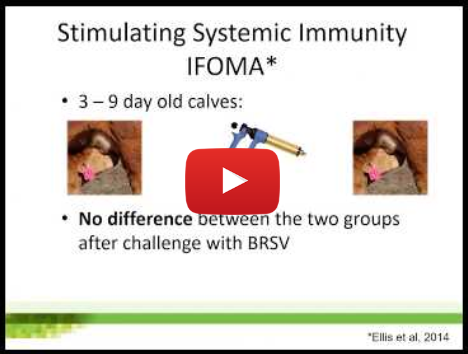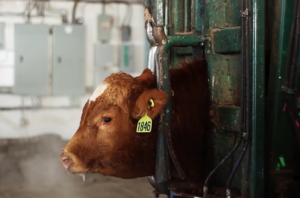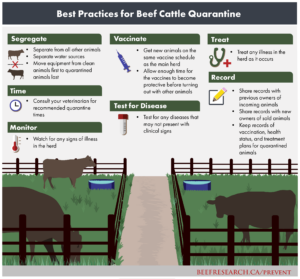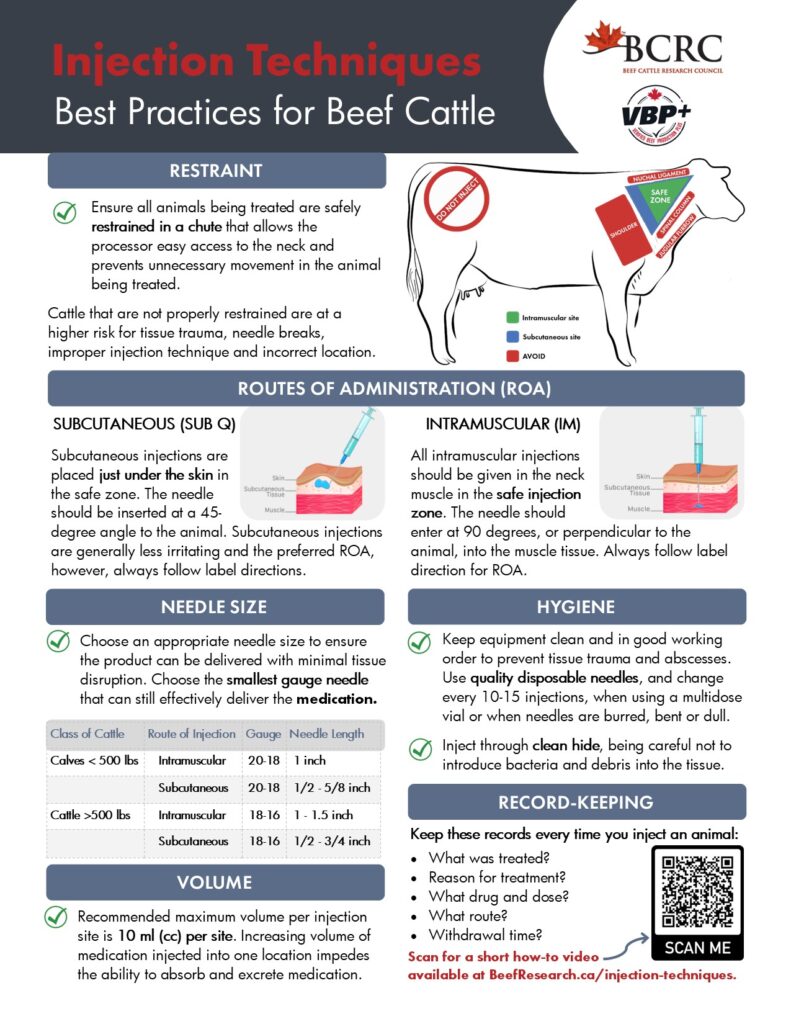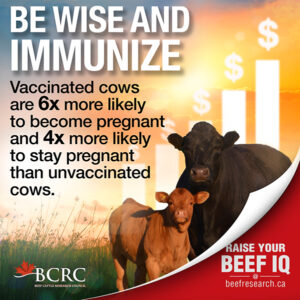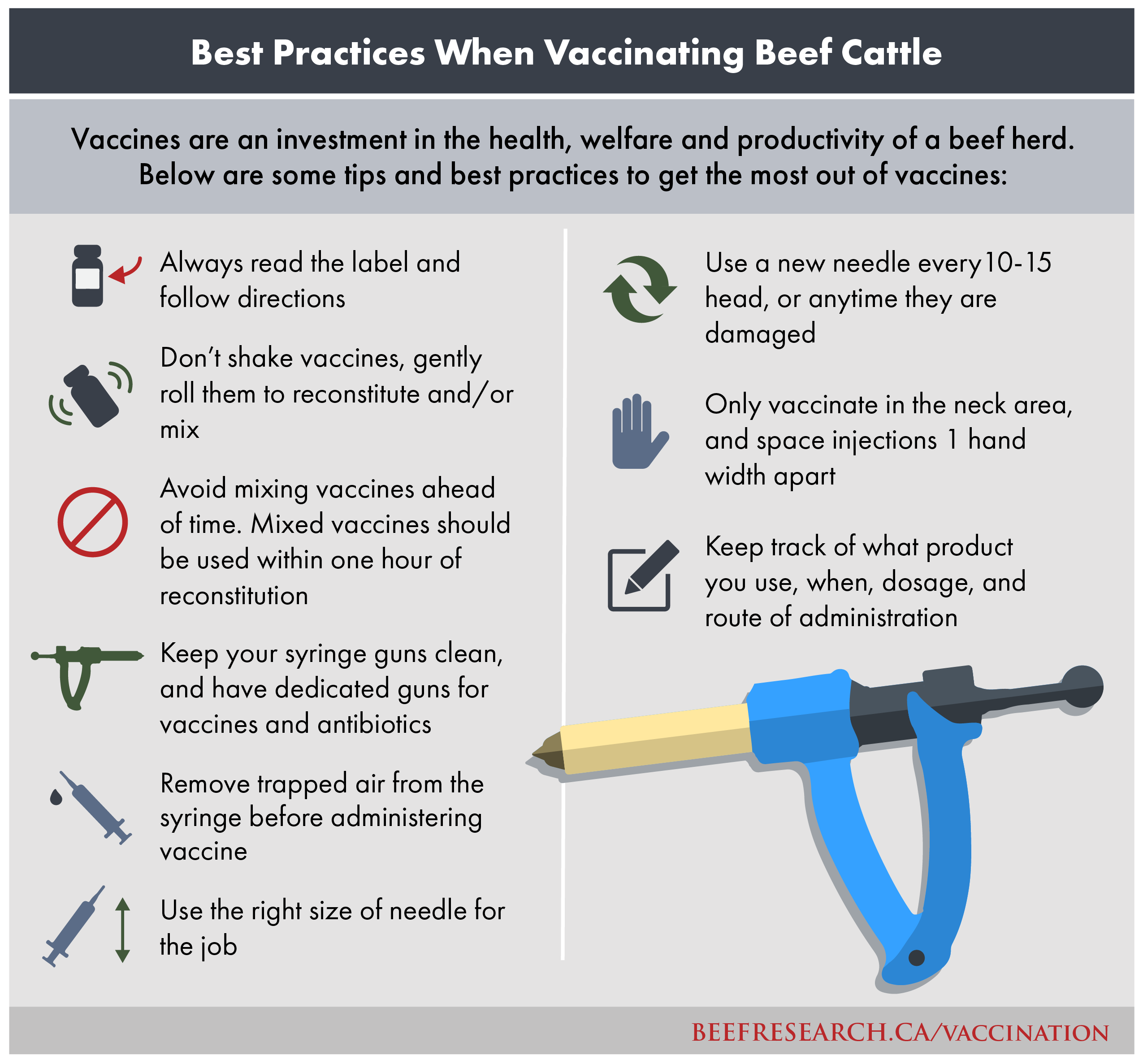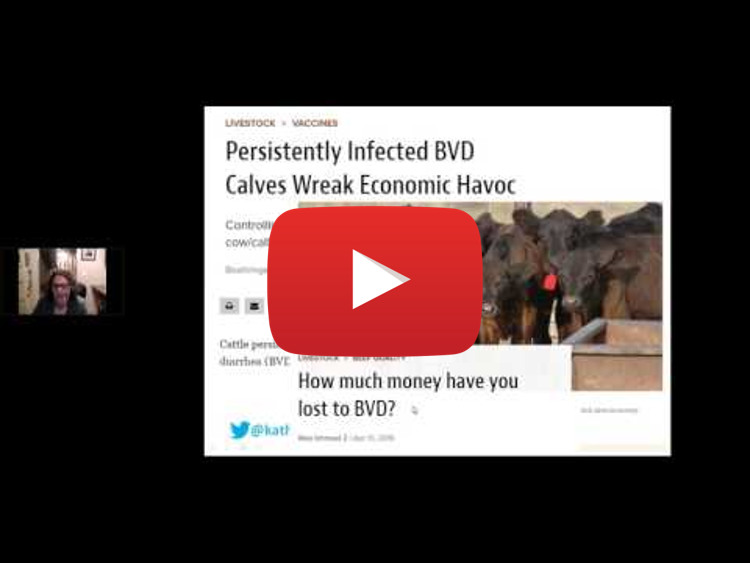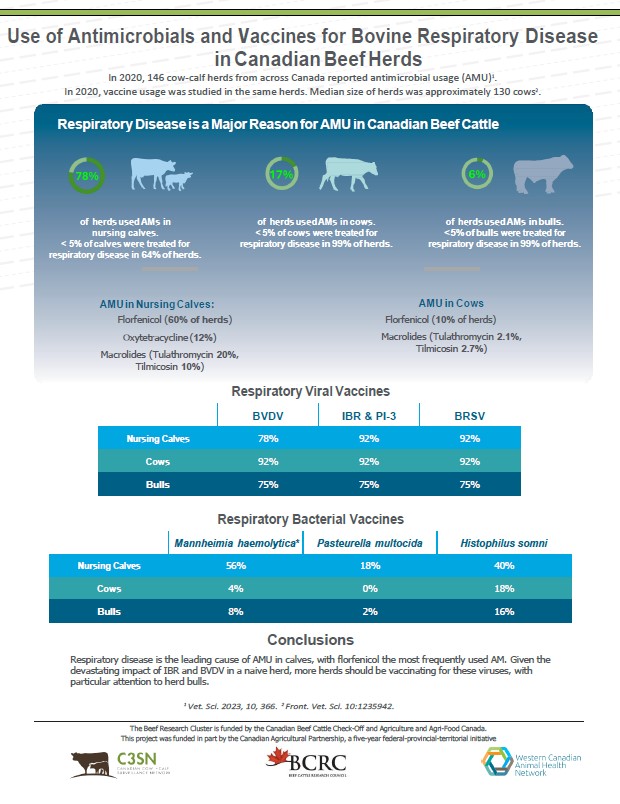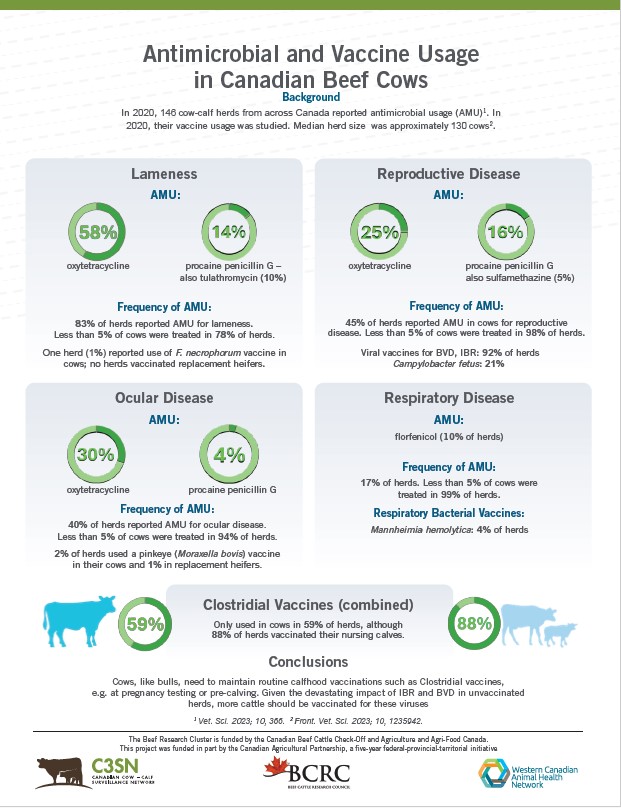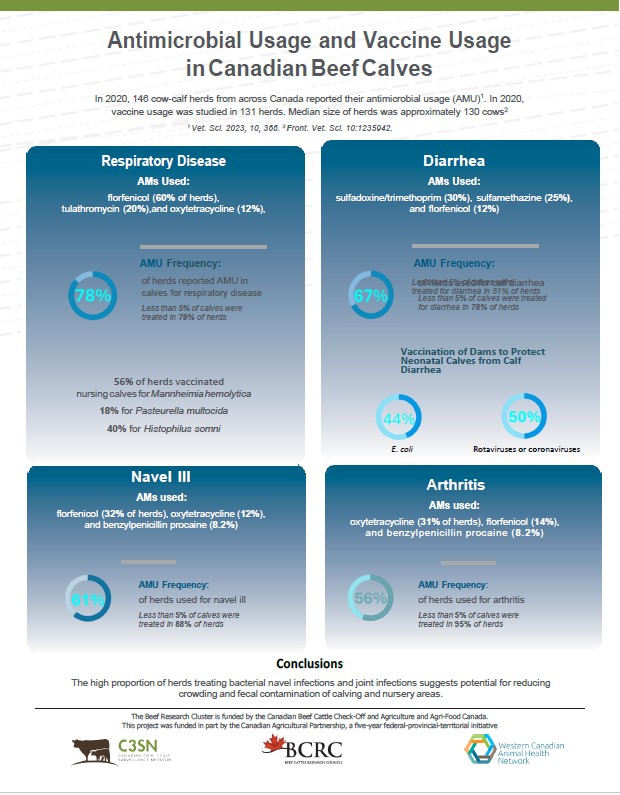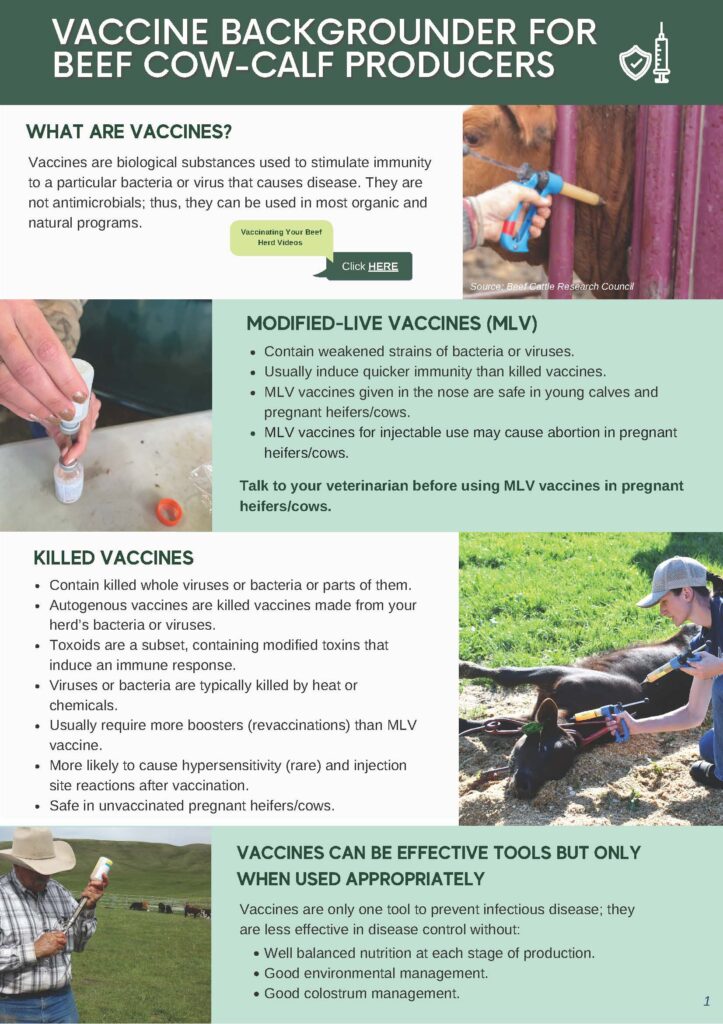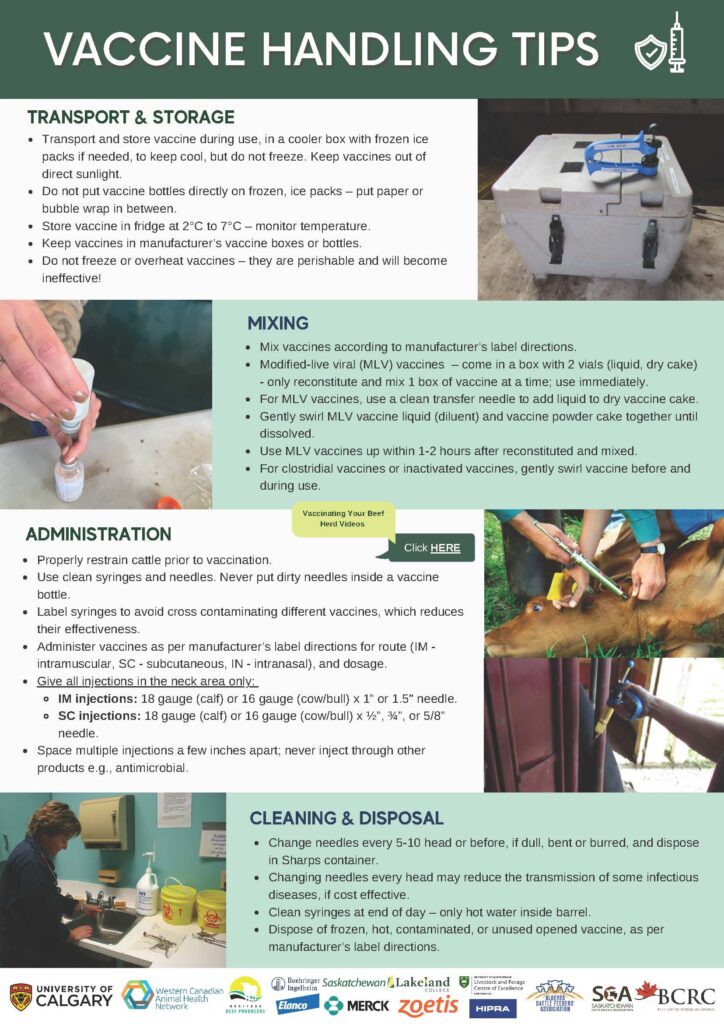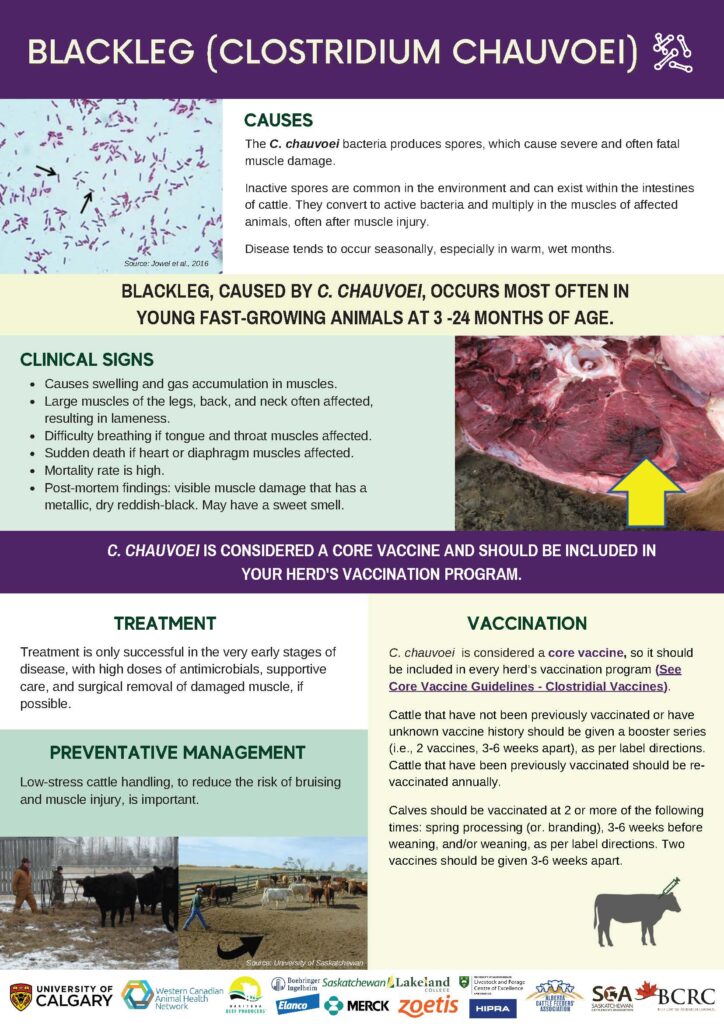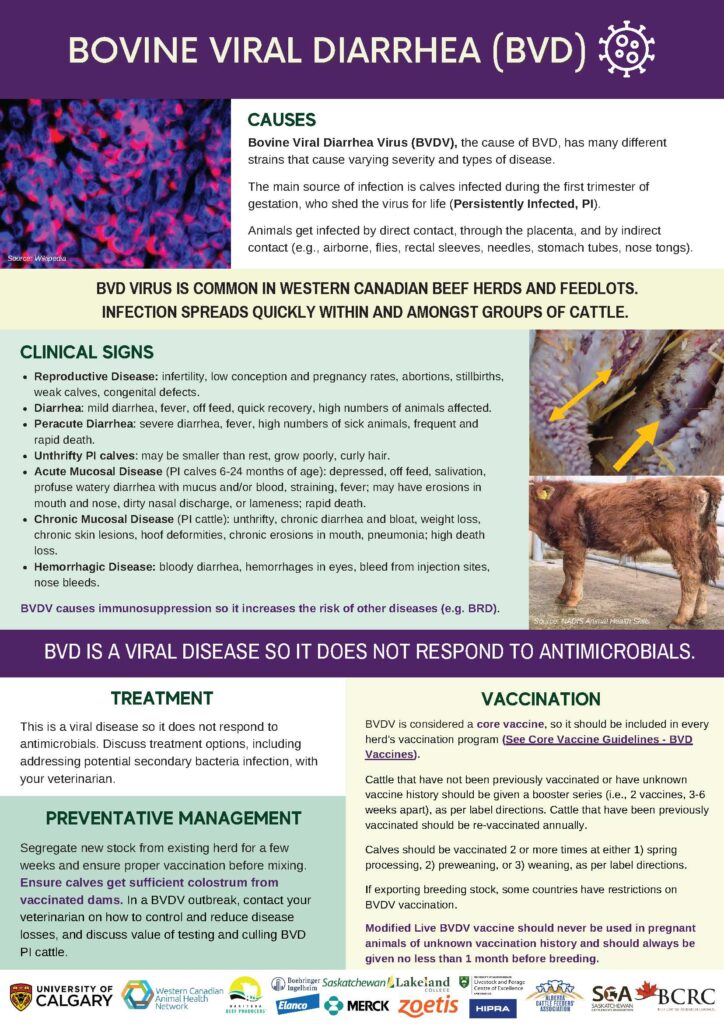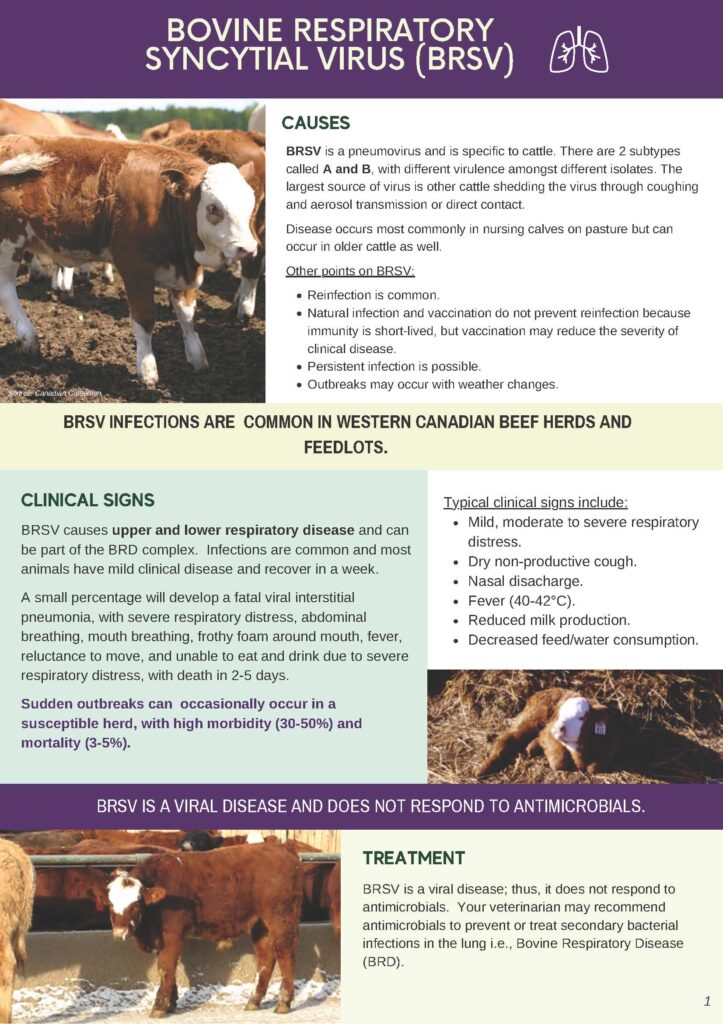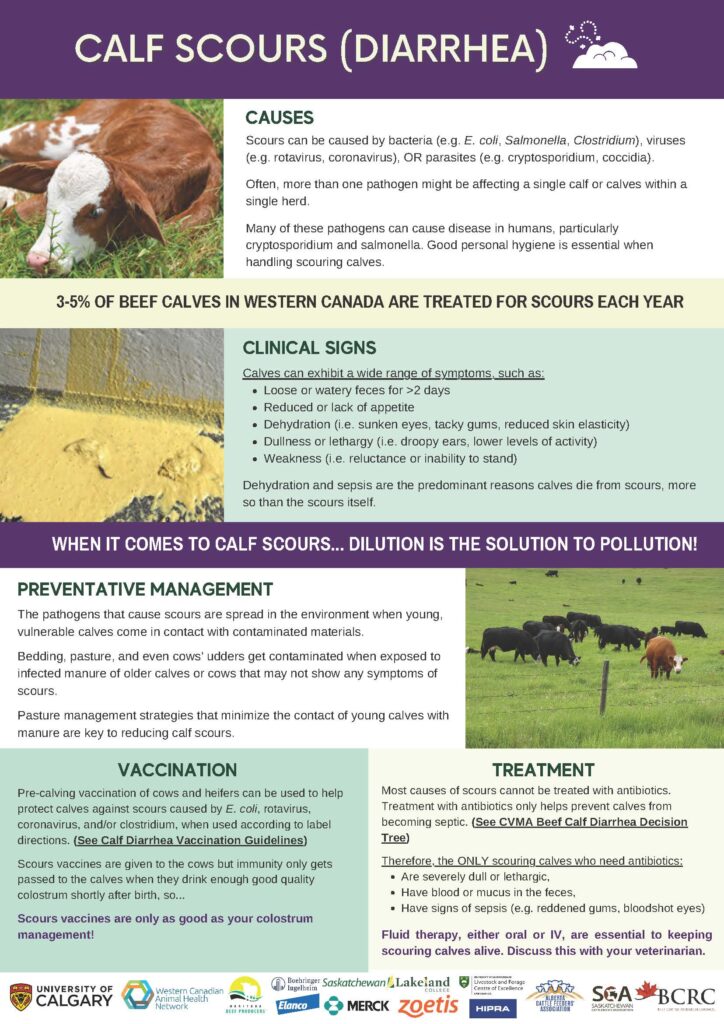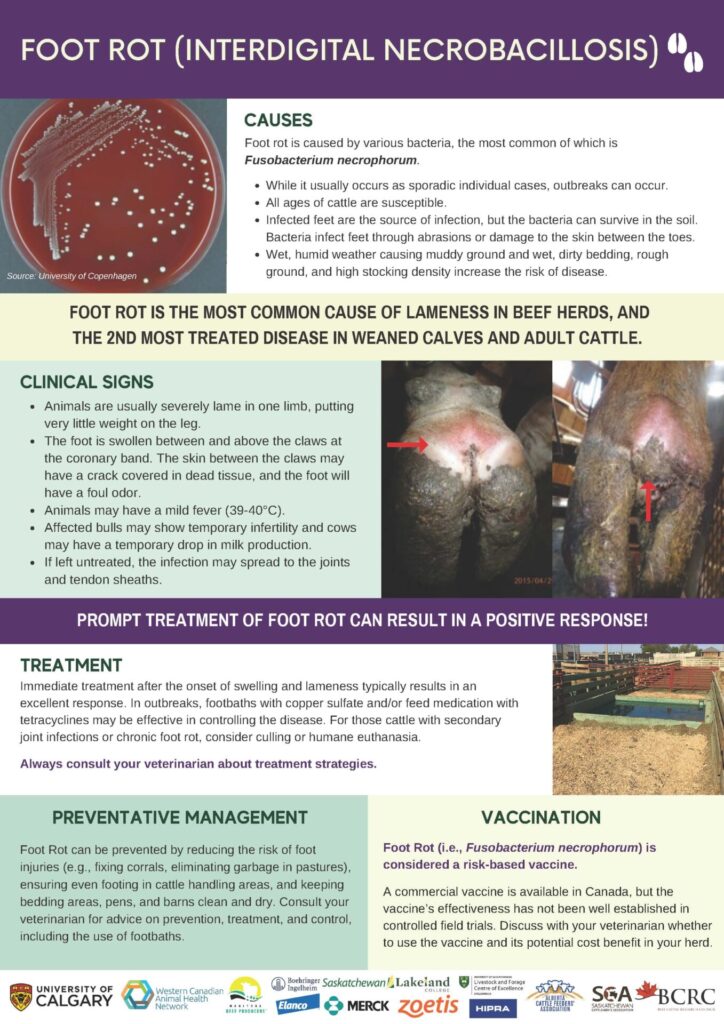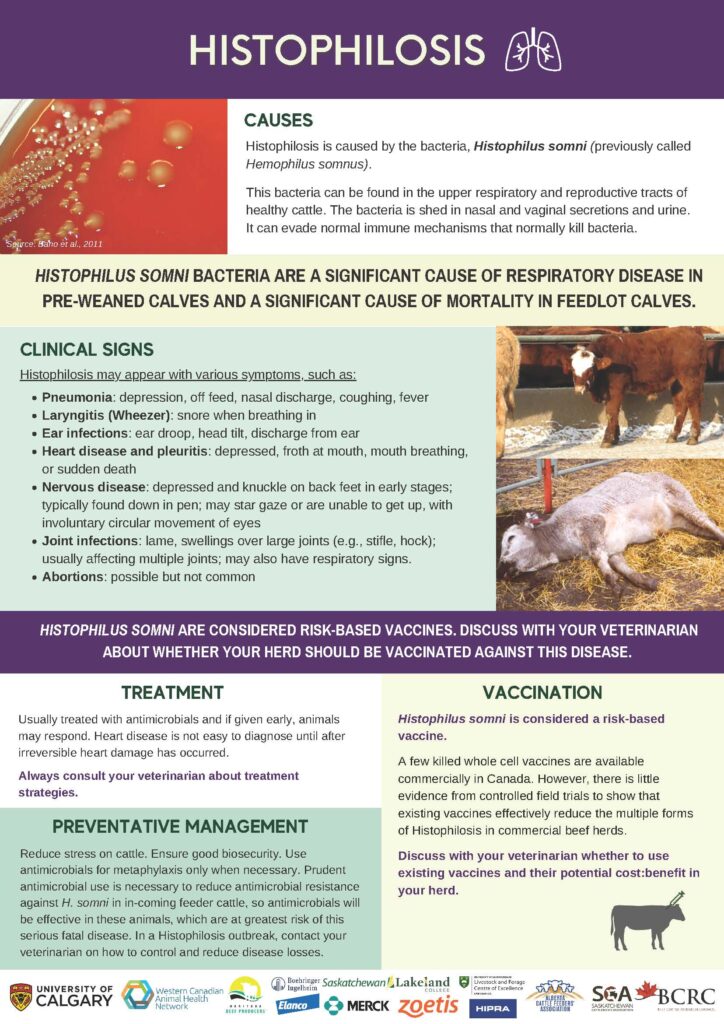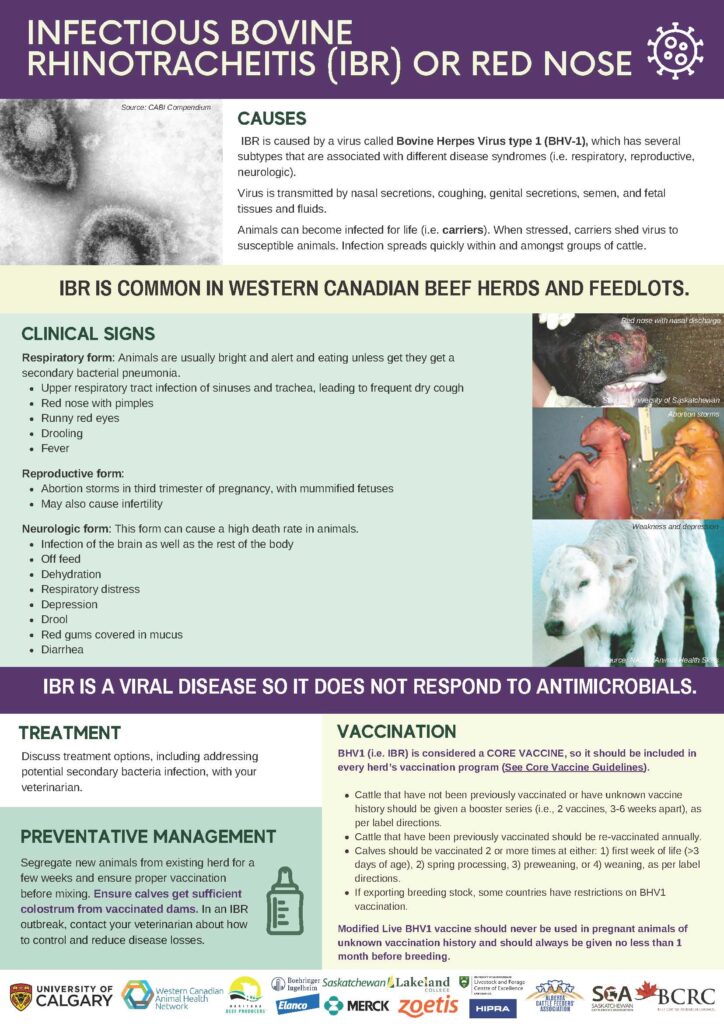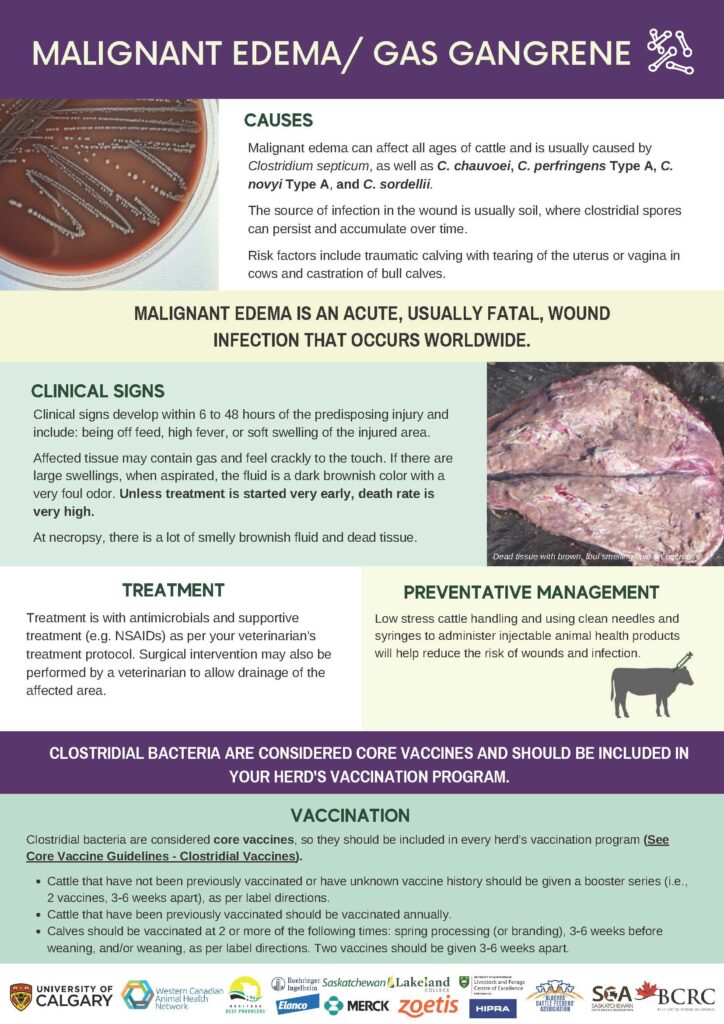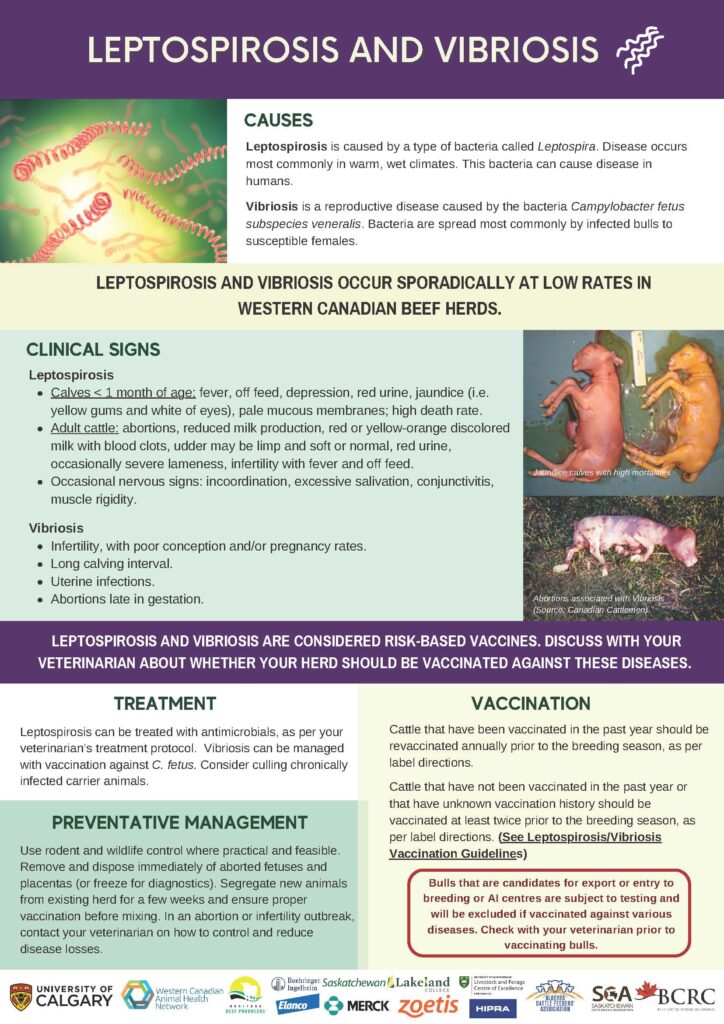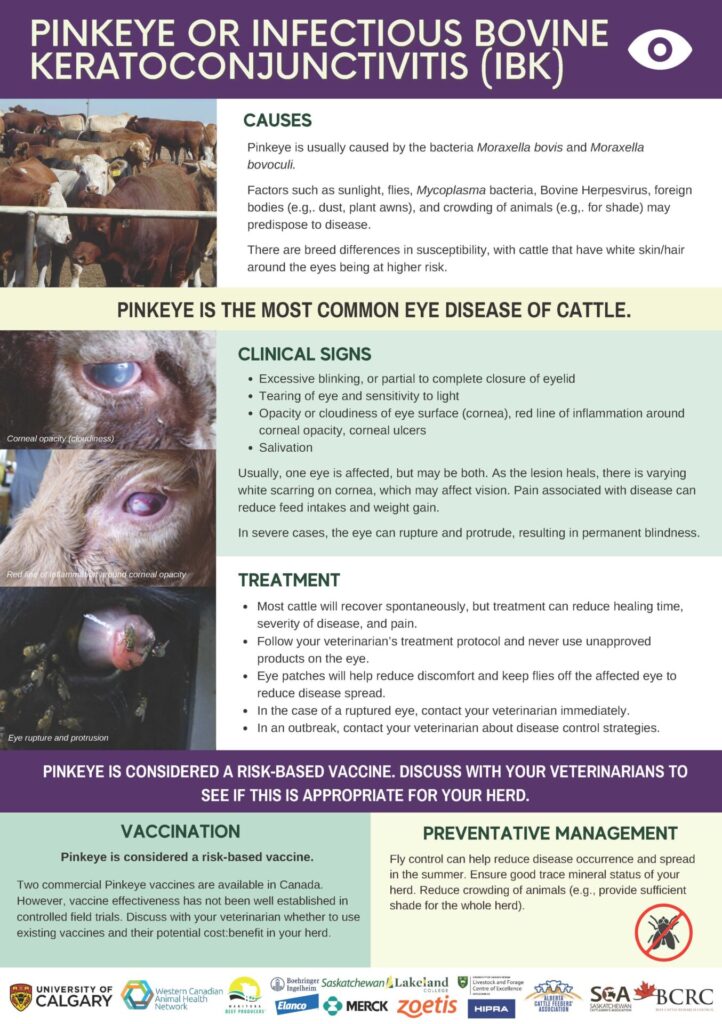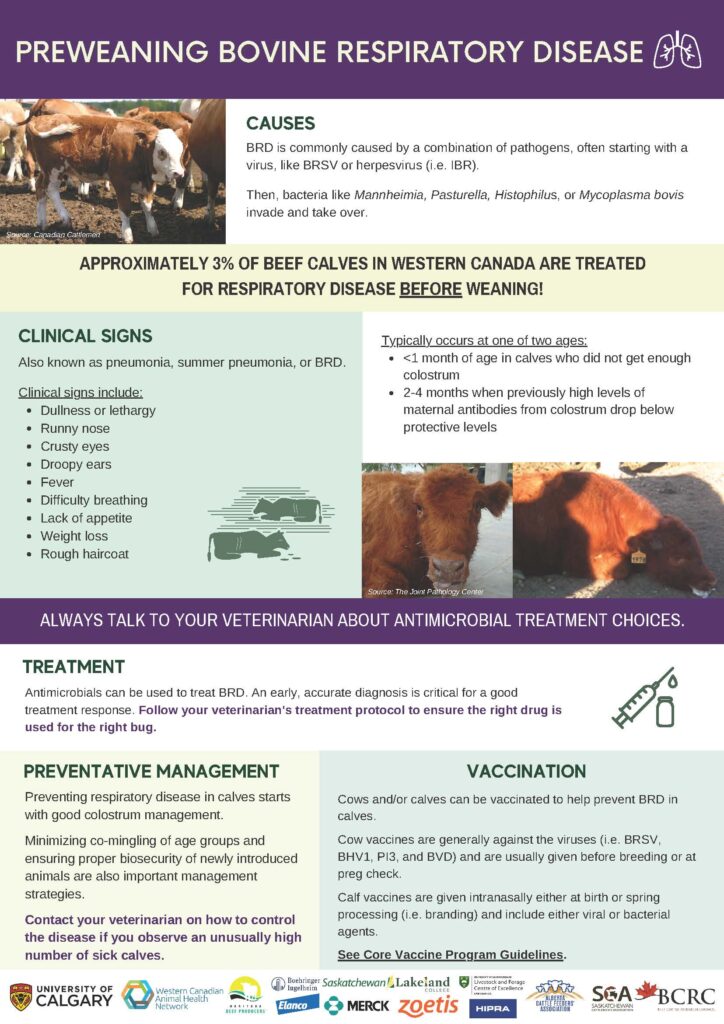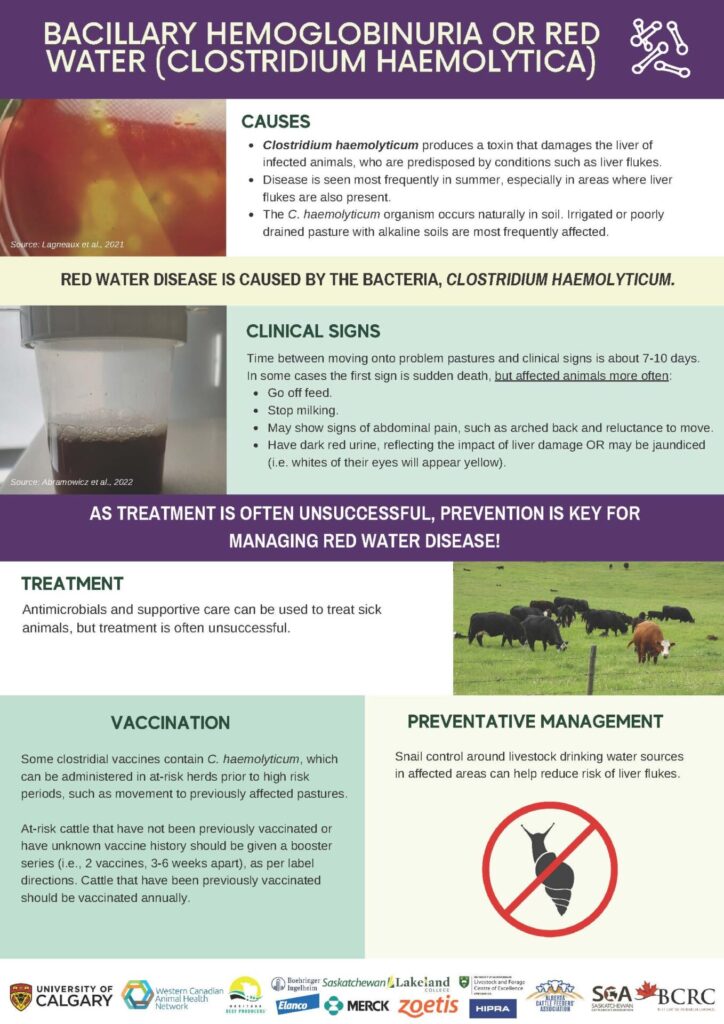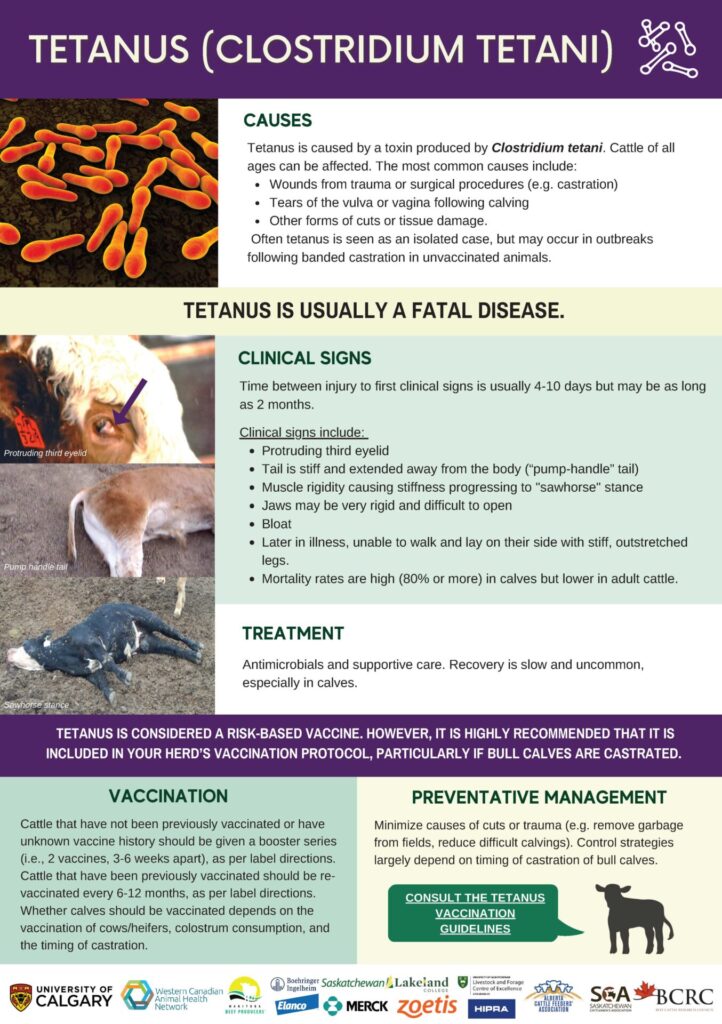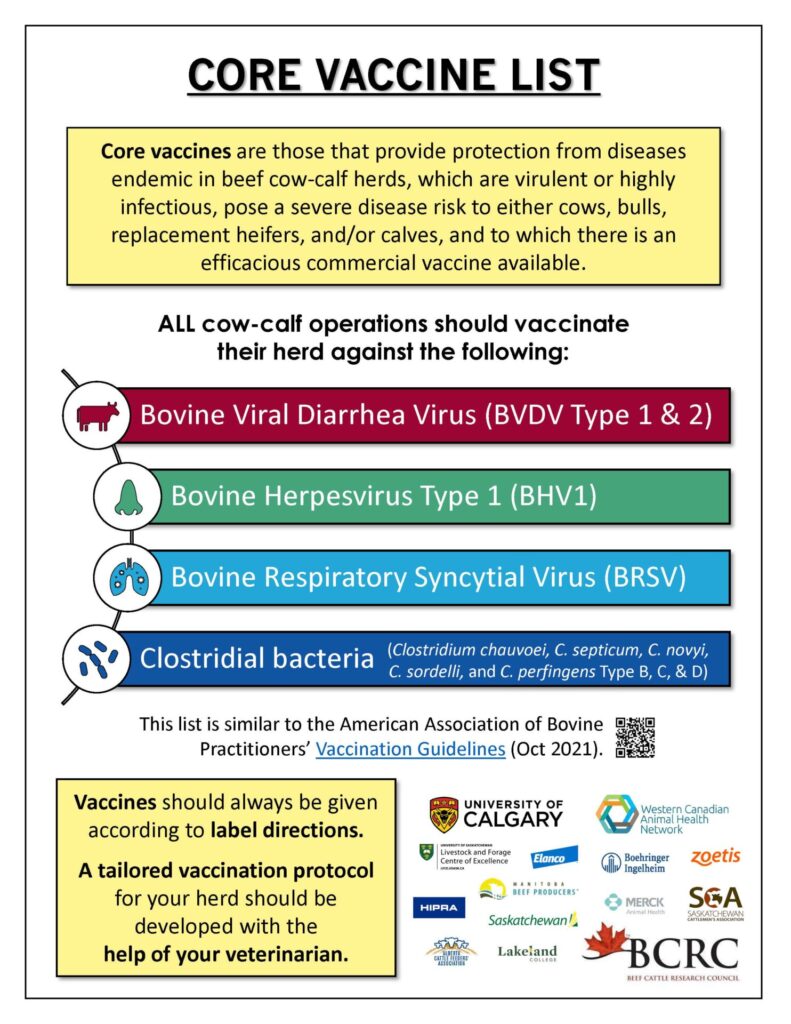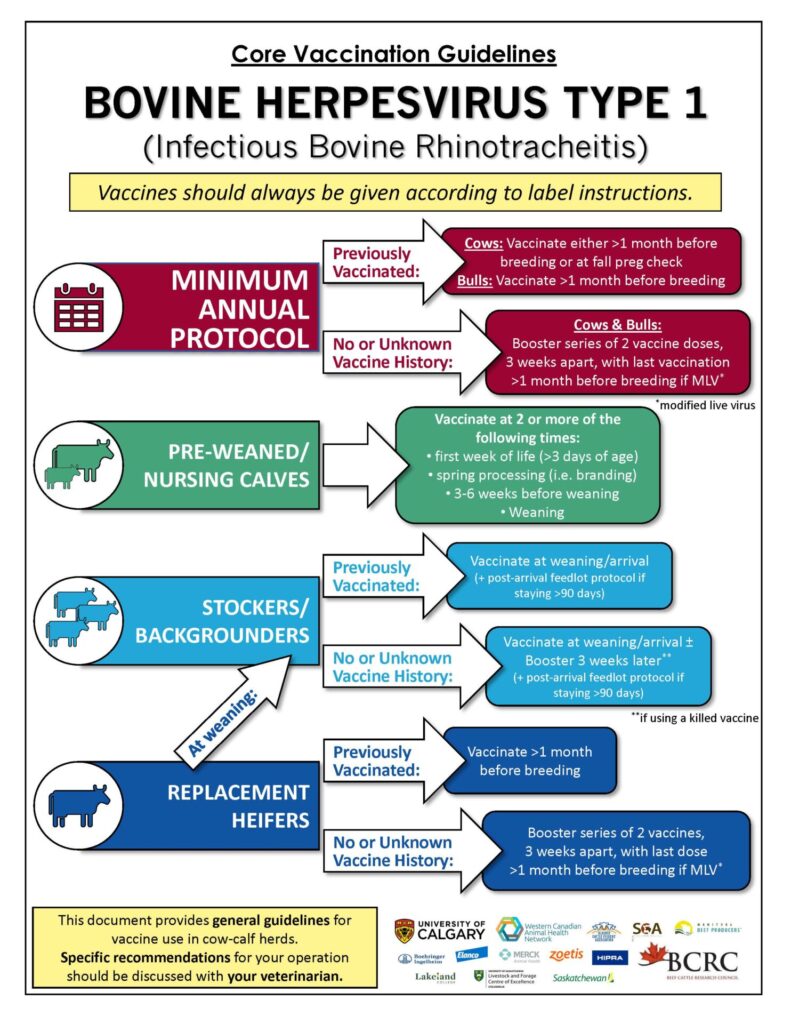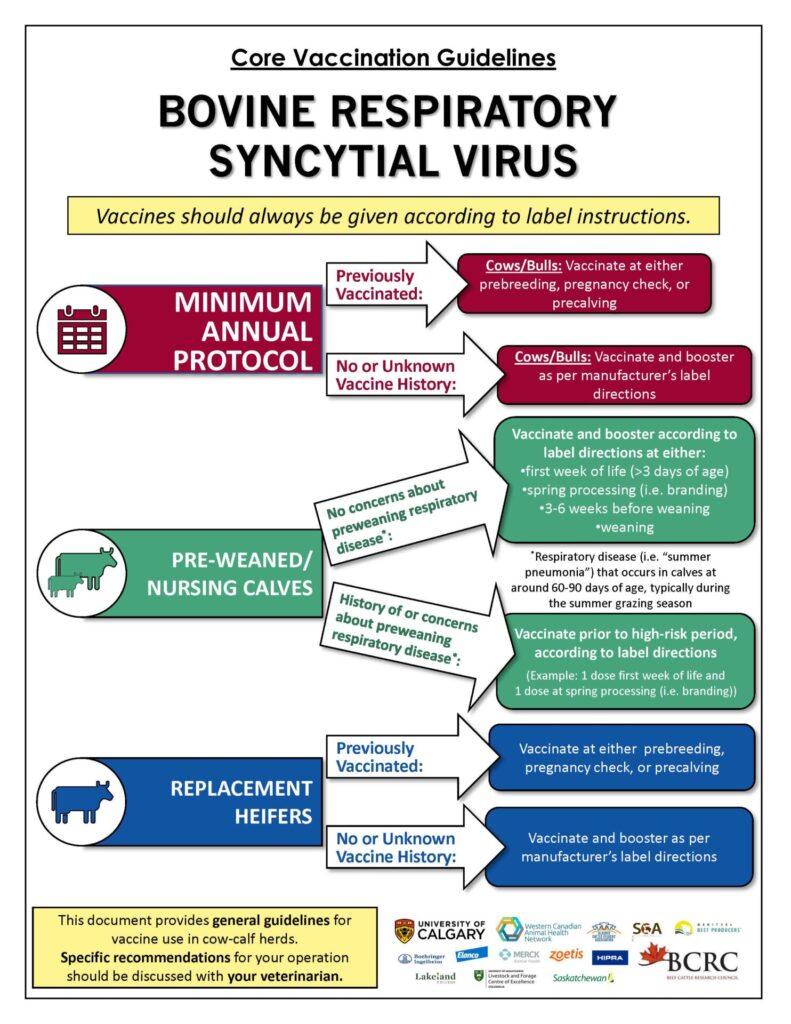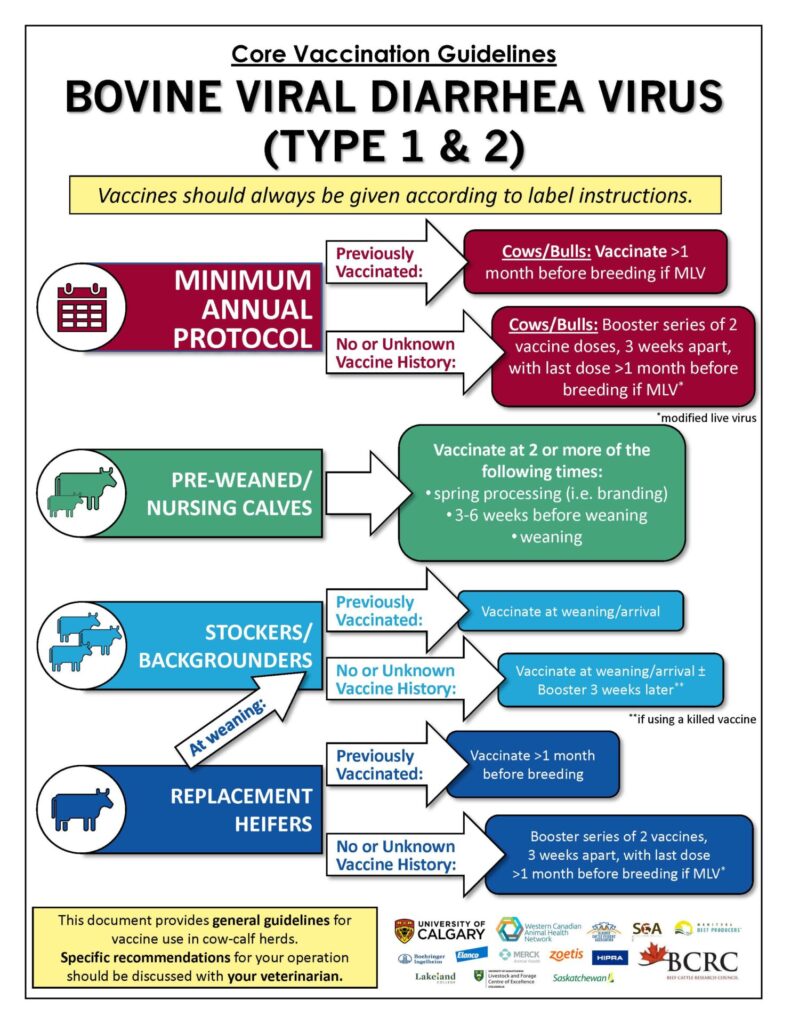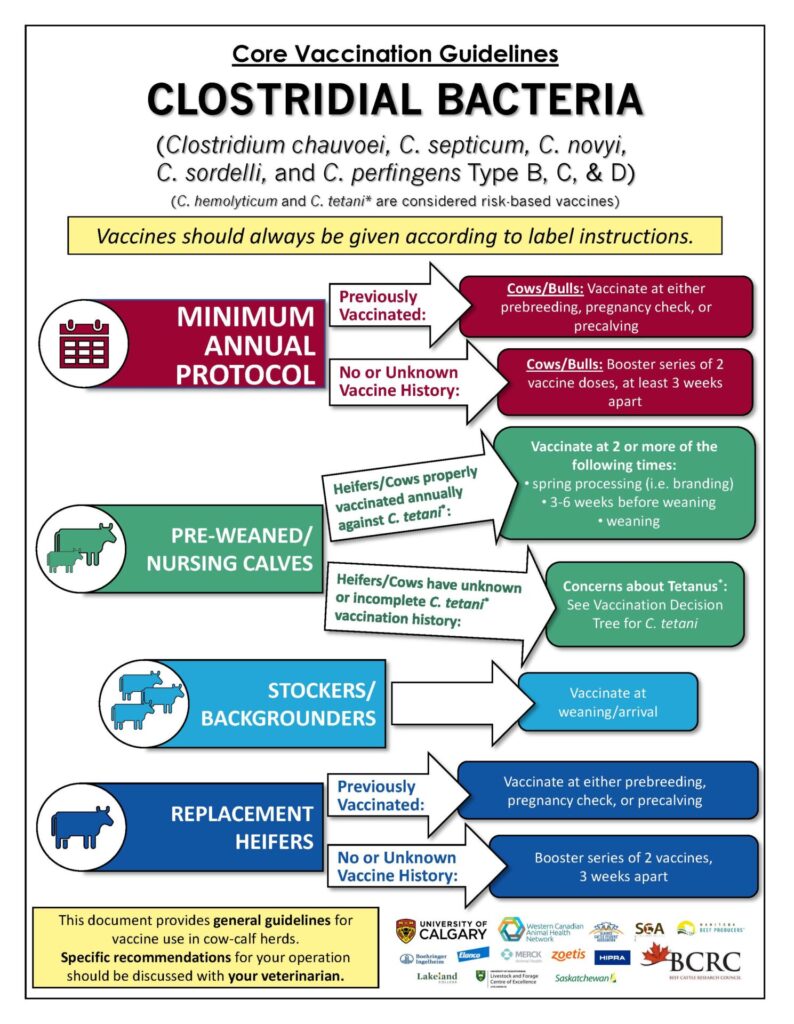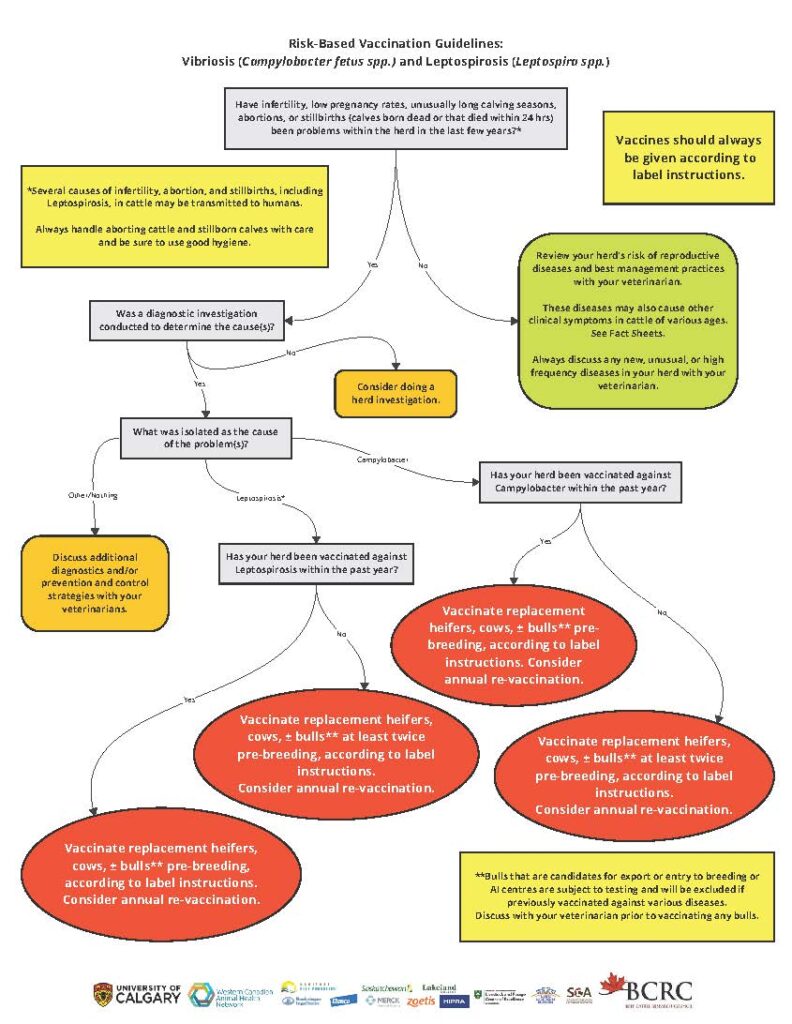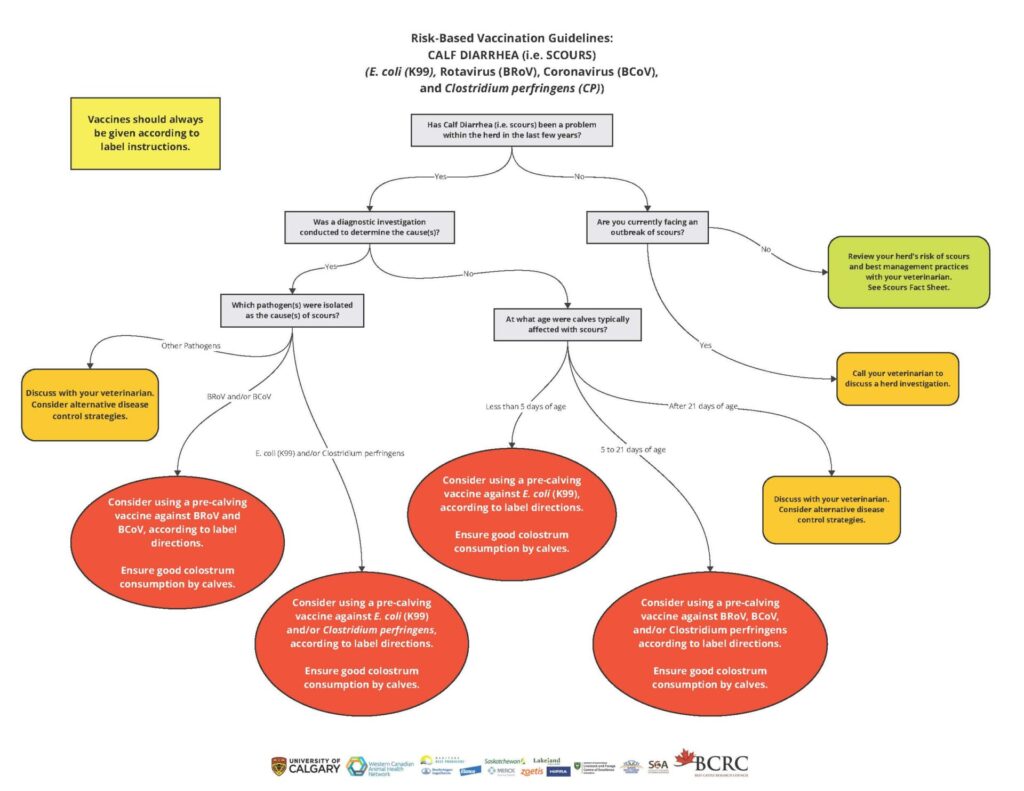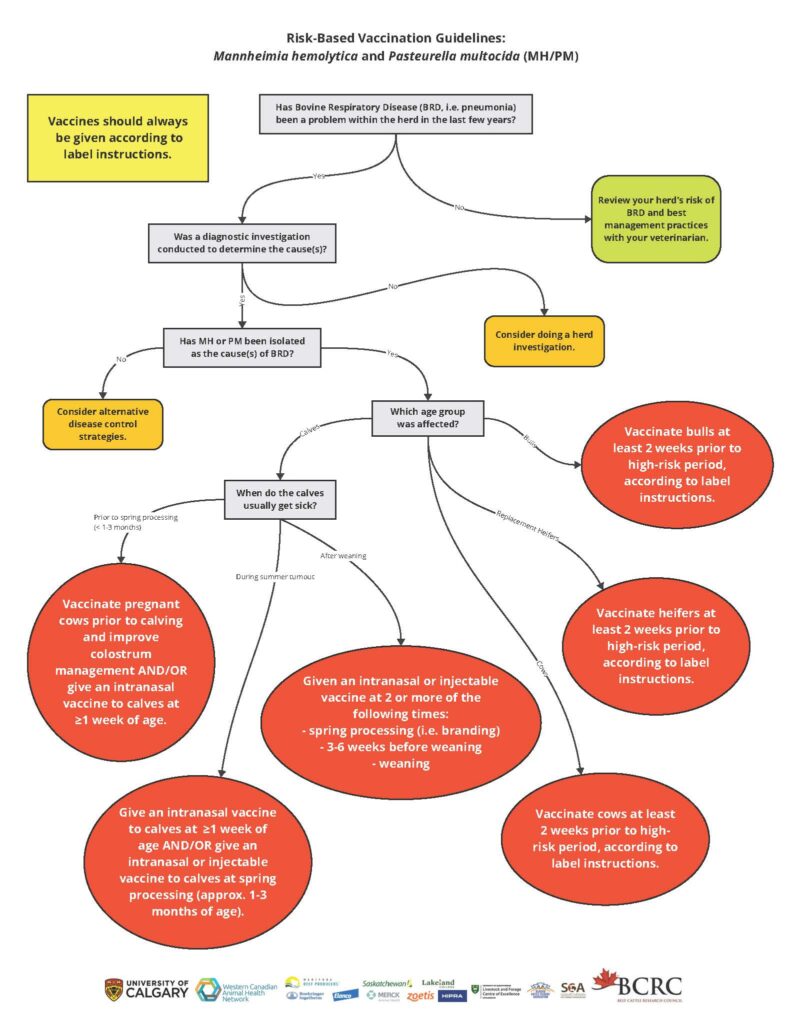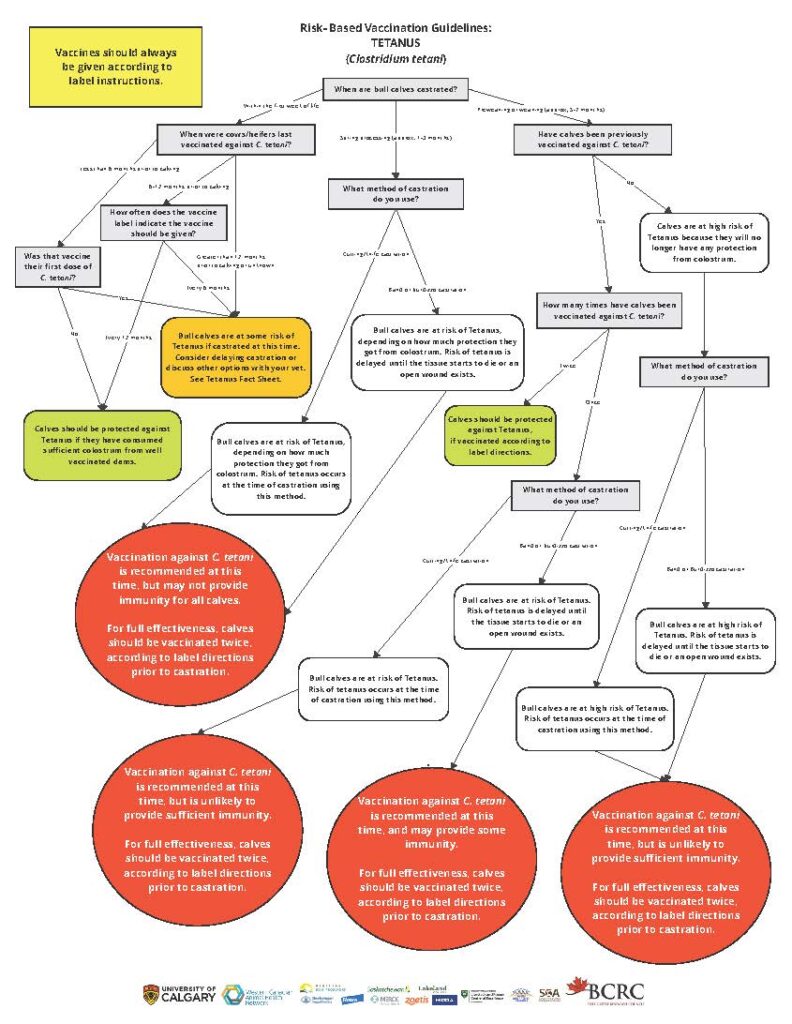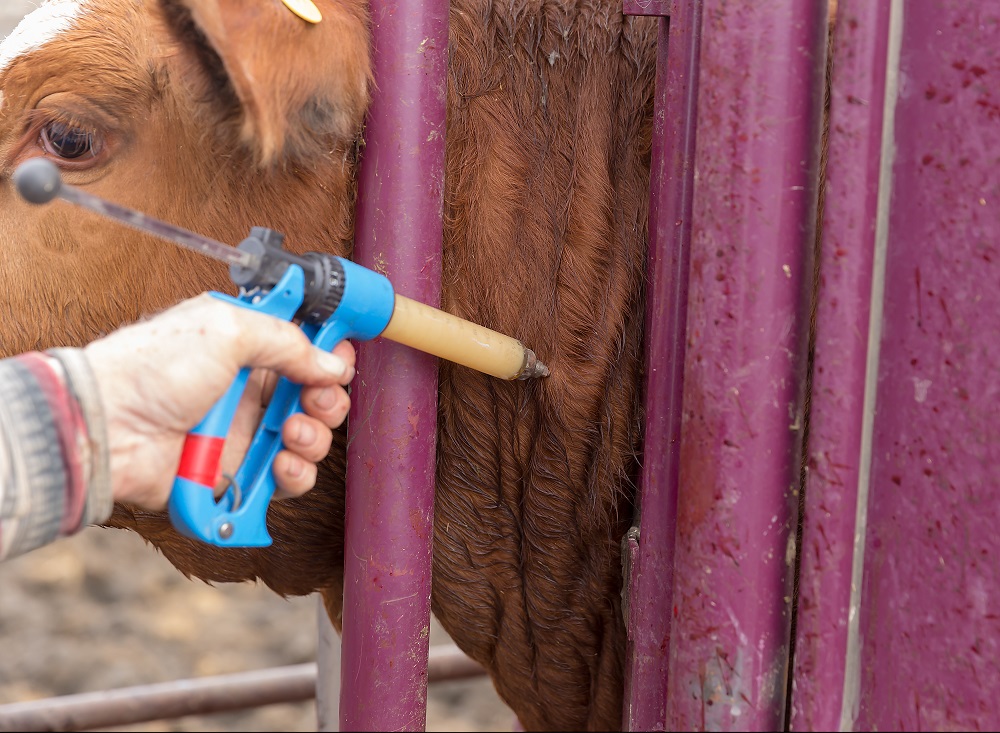
Vaccines stimulate the immune system of the animal to produce antibodies. Antibodies (or immunoglobulins) are proteins created by cells in the blood. Antibodies can also be created in various lymphoid tissues that can be found in the intestine or upper respiratory tract. These specific proteins help to destroy various infectious organisms that can cause disease. Cattle also produce antibodies when they are naturally exposed to infectious organisms. Vaccines are a primary component of our modern herd health programs, but it is important to remember that they rarely provide absolute protection and other management components such as biosecurity, nutrition and environmental management also play important roles in protecting the herd from infectious diseases.
| Key Points |
|---|
| Vaccines train the animal’s immune system to recognize disease-causing viruses, bacteria, and parasites (infectious pathogens) so that it can respond quickly when the animal is exposed to the real thing. Vaccines need to be given prior to disease exposure so that the immune system has time to develop these protective mechanisms. |
| Vaccines should be distinguished from other therapeutic drugs such as antimicrobials. Vaccines are primarily used to prevent a specific disease from occurring by creating immunity. Antimicrobials and most other therapeutic drugs are used to treat or control a specific disease condition using chemical means rather than through the animal’s immune system. |
| Vaccines can be divided into categories based on whether they are killed/inactivated or modified live and by their route of administration (injectable vs intranasal). |
| The immune system is extremely complex, but there are two basic components called humoral immunity (concerning antibodies) and cellular mediated immunity (which is associated with other cellular protection mechanisms). Vaccines can stimulate both types of immunity. |
| Vaccines are a key component of our herd health programs but rarely provide perfect protection. Their efficacy can be diminished due to improper use, inadequate nutrition, poor biosecurity, and poor environmental management. |
| Read the label on any vaccine you are about to use in your cattle. The dose, instructions for handling and mixing, withdrawal times, expiration date, timing, route of administration and safety information are all there. This is important for all vaccines but especially so for some modified live vaccines that can cause abortion if administered inappropriately. |
| Work with your veterinarian to design a vaccination protocol that is appropriate for your herd. Issues such as exposure to other herds and geographic differences in disease risk will make every herd somewhat unique. Vaccines that protect against infectious bovine rhinotracheitis, bovine viral diarrhea, and clostridial diseases should definitely be a part of every herds’ vaccination protocol. However, the timing of administration and the other vaccines that need to be used will be highly dependent on individual herd management and disease risks. |
Immunology 101: Definitions
Antigen: Any substance capable of inducing an immune response such as viruses, bacteria, toxins, and parasites.
Antibody (Immunoglobulin): A protein that is produced as the result of the introduction of an antigen into an animal. Antibodies are created within certain blood cells and in lymphoid tissue associated with the upper respiratory tract and intestinal tract. Antibodies react specifically with a particular antigen or one closely associated with it.
Passive immunity: Most commonly, this results from antibodies that are passed on from the cow to the calf through colostrum. These antibodies provide immune protection to the calf until it is able to create its own antibodies.
Active immunity: When an animal actively produces its own antibodies as a result of being exposed to an antigen. This can occur with a natural infection or when we vaccinate animals.
Mucosal immunity: Immunity associated with mucosal lymphoid tissue sites such as the intestinal tract, tonsils and upper respiratory tract. Antibodies are created that are present on mucosal surfaces which may help to neutralize a pathogen before it gains a foothold. Intranasal vaccines may be better at creating mucosal immunity.
Systemic immunity: Most injectable vaccines focus on creating systemic immunity where antibodies are created in the blood and extracellular fluid. Once a pathogen gains entry to the blood stream, the antibodies can potentially neutralize it.
Pathogen: Disease-causing agent such as a bacteria, virus or parasite.
Naïve animal: An animal that has never been exposed (through natural infection or vaccination) to a certain bacteria or virus before and therefore has no immunity to it.
The Immune System
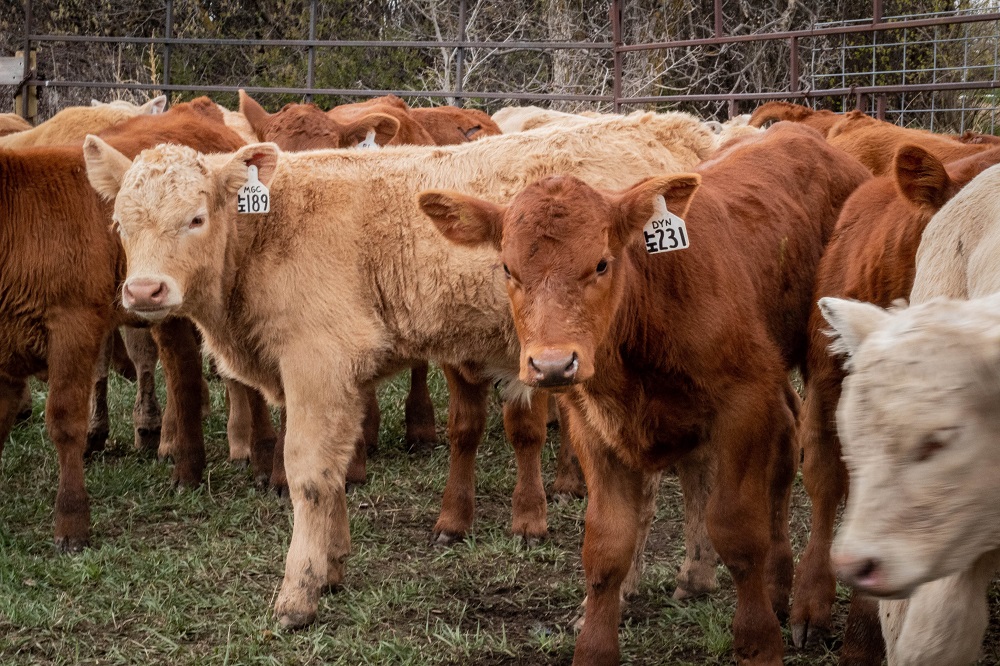
When cattle are exposed to infectious pathogens, the immune systems are stimulated to respond to these infections. It takes time for this complex machinery to respond to a pathogen (a disease causing agent) when it is initially exposed to the antigen (either through vaccination or natural infection). As a result, antibodies aren’t created in time to prevent disease from occurring on initial exposure. However, the immune system is able to “learn” and develop a specific response to a pathogen such as a particular bacteria or virus or parasite. This is important because when an animal is exposed to the disease for a second time, the immune system has memory cells that are programmed to respond to antigens they have previously encountered. The immune system can now respond much more quickly in creating antibodies as it already has the needed components to create the necessary antibodies. This allows the body to “throw off” the infection, sometimes without any signs at all.
Vaccines work by using an altered antigen that does not cause disease, but rather essentially causes the immune system to think it has been invaded by the actual infectious bacteria or virus. The immune system then creates antibodies along with memory cells that may remain for months into the future. If the animal becomes exposed to an infectious disease pathogen, its immune system can respond rapidly and prevent an infection from occurring or reduce the severity of infection.
Two Major Components of the Immune System
Humoral Immunity
Humoral immunity is that part of the immune system that results in the production of antibodies.
- An antibody is a small “Y” shaped protein produced by immune cells in the blood or on mucosal surfaces. They are also known as immunoglobulins.
- The shape of the end of the “Y” allows the antibodies to interact with specific proteins and sugars and to bind to them. It is a bit like a lock and a key mechanism.
- You need a specific antibody to bind with a specific protein on a bacteria or virus or parasite.
- When an antibody is recognized as being useful for fighting infection, the body immediately up-regulates production of that particular antibody type.
- Antibodies are made by B lymphocytes, a type of white blood cell (WBC).
- Each B lymphocyte produces a different antibody shape.
How Do Antibodies Work?
- Some antibodies bind to the attachment proteins (antigens) on bacteria or viruses and prevent them from attaching to body cells (e.g. E. coli calf scours vaccines – the E. coli causing calf scours binds to the wall of the gut using an antigen protein called K99). Antibodies to this K99 antigen protein prevent the E. coli from attaching and it is swept through the gut and is unable to colonize or cause disease.
- When antibodies bind to a foreign antigen, they can also signal the start of other cellular defenses targeting them directly to the invader, destroying bacteria.
- Bound antibodies can also help attract special cells from the immune system to phagocytose (eat and destroy) the invader.
- Many bacteria produce disease by releasing protein toxins. Antibodies can bind and inactivate these toxins preventing disease (e.g. 8-way vaccine contains eight inactivated clostridial toxins).
Cellular Immunity
Humoral immunity and antibodies are just one aspect of the immune system that protects against disease. Cell mediated immunity does not produce antibodies but involves the activation of specific white blood cells that are able to actually destroy cells where viruses or bacteria may be hiding. Cell mediated immunity can also stimulate cells in the immune system to release proteins called cytokines that can signal other cells to initiate an inflammatory response. Cell mediated immunity is more important than antibodies against certain bacteria and viruses that tend to hide in the host body cells. Vaccines can help to stimulate cell mediated immunity as well as humoral immunity. Some types of vaccines might work better than others for stimulating cell mediated immunity.
Types of Vaccines
Most vaccines can be divided into two main categories, modified live vaccines and killed/inactivated vaccines.
Modified Live Vaccines (MLV)
These vaccines contain living bacterial or viral organisms. The infectious organism has been “modified” or attenuated by growing the virus in abnormal host cells or by growing a bacteria on an abnormal media. As they replicate this cycle over and over, the virus or bacteria begins to lose some of the factors that may cause disease and the newly modified living bacteria or viruses can now multiply in the animal and stimulate immunity, but without causing disease. These vaccines often are produced with two separate vials, a sterile solution or diluent and a powder that are mixed together just before using. A newer modification of the MLV are genetically engineered vaccines where the pathogen is genetically altered usually through a mutation or gene alteration. Most MLV are only available through veterinarians to ensure that producers receive appropriate instruction on their use.
Advantages of Modified Live Vaccines:
- Only need a small dose as the living organism actually replicates inside the animal
- May not require a second (booster) vaccination
- Can create a slightly more rapid immune response
- Vaccination with MLV tends to create a stronger and longer-lived immune response
- Tend to have a shorter meat withdrawal time
- Tend to do a better job of stimulating cell mediated immunity
Disadvantages of Modified Live Vaccines:
- Require very careful storage to avoid killing the live organism (refrigeration)
- Require on-farm mixing
- Require careful handling and clean syringes (not contaminated with soaps or disinfectants) to avoid killing the live organism
- Must be used immediately after mixing and cannot keep a partially used vial
- Some modified live vaccines can cause abortions if given to naïve pregnant animals
Killed/Inactivated Vaccines
Killed or inactivated vaccines usually involve isolating a field strain of a bacteria or a virus from an outbreak of disease, growing the pathogen, then killing it through chemical or physical means (e.g. adding a chemical such as formalin or by using ultraviolet light). This killed organism can then be injected without causing disease, but the various proteins on the bacteria or virus that cause an immune response are still present.
Toxoid vaccines are a specific type of inactivated vaccine. Some bacteria such as the clostridial organisms that cause blackleg, tetanus, redwater and other diseases do most of their damage by releasing toxins. These toxins can be produced in a laboratory and then inactivated through chemical means. Clostridial vaccines (7- or 8-way vaccines) that are commonly used in the cattle industry are the most common example of a toxoid vaccines.
Advantages of Killed/Inactivated Vaccines and Toxoids:
- No possibility of vaccine organism spreading between animals
- Safe for pregnant animals – minimal risk of abortion
- No on-farm mixing required
- Can potentially store (refrigerated) and re-use partially used vials if careful handling and sterile techniques are used
Disadvantages of Killed Vaccines:
- Need a lot more antigen and a chemical adjuvant to boost the immune response as the organism cannot replicate within the host
- Usually need two doses to get an adequate immune response because the vaccine antigen does not multiply within the vaccinated animal as it can with MLV
- Cell mediated immunity is not usually stimulated as efficiently
Vaccination Cost-Benefit Calculators
The BCRC has two calculators that help beef producers determine potential savings from vaccinating cattle.
The Bovine Respiratory Disease (BRD) Cost-Benefit Calculator allows producers to input the number of feeder calves, price, feed weight, cost of gain, days on feed and expected fed cattle price to see the potential savings from sourcing feeder cattle that have been vaccinated for BRD.
Click to download [.xlsx file | 95kb]
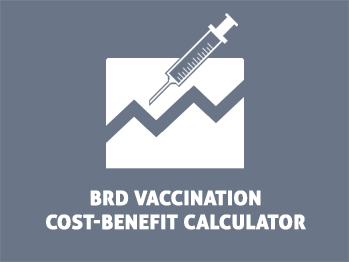
With the Bovine Viral Diarrhea (BVD) Cost-Benefit Calculator, producers input herd size, expected price, animal weights, cost of vaccine and labour to estimate the potential savings from vaccinating cattle for BVD.
Click to download [.xlsx file | 96kb] Updated Nov. 2021
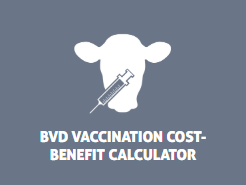
Routes of Administration
Just as vaccines can be divided into categories based on whether they are modified live or killed vaccines they can also be divided into categories based on their route of administration.
Injectable Vaccines
Most of our vaccines are administered by injection either subcutaneously (under the skin) or intramuscularly. These types of vaccines tend to be best at stimulating systemic immunity although they may create some level of mucosal immunity as well.
Intranasal Vaccines
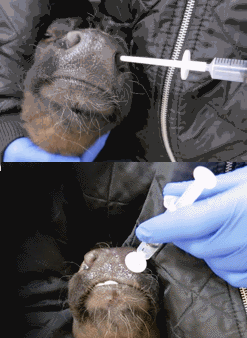
These vaccines are more geared towards stimulating mucosal immunity although some systemic immunity may also be created. These vaccines interact with the lymphoid tissue in the upper respiratory tract to create antibodies at the surface which can then potentially inactivate the pathogen before it enters the animal. Although we don’t have many oral vaccines in the cattle industry, these would also fall into this category as they tend to stimulate local mucosal immunity in the gut.
See the BCRC blog post, Intranasal Vaccines Are Timely And Effective, for more information on the use of these types of vaccines.
The following webinar provides an overview of how to use nasal vaccines effectively.
Video: Stimulating Systemic Immunity
Why Don’t Vaccines Always Provide Protection?
Video: Pink eye vaccination research conducted at VIDO
Veterinarians are often asked to investigate apparent vaccine failures in which vaccinated animals do not seem to be adequately protected by the vaccine which was given. Although no vaccines can guarantee 100% protection, many cases of vaccine failure are caused by one of the following reasons:
1. The animal was already incubating disease when the vaccine was administered. The lag time for the immune system to start producing antibodies is at least one to two weeks following vaccine administration. If the animal is exposed to the virus or bacteria prior to the vaccine being administered or even shortly afterwards the vaccine may appear to be ineffective. However, it is simply because the animal was already incubating disease before the immune system could respond to the vaccine. For vaccines that require boosters, both doses are necessary to get the best protection prior to exposure. However, even one dose might help if the vaccine is in place on time before the animal is infected.
2. The vaccine was administered incorrectly. Read the label and follow the directions! Consult your veterinarian if you have questions. Many vaccines can be given subcutaneously (under the skin) but some can only be given intramuscularly. Some vaccines are only designed for intranasal application. Incorrect administration or less than adequate dosages may not stimulate an adequate immune response. Check your automatic syringes to ensure that they are working correctly and administering the correct dose of vaccine.
3. The vaccine was not boostered correctly. As stated above, it is very important to follow the label directions on all vaccines. Many killed or inactivated vaccines and some modified live vaccines require a booster vaccine to be given at some point after the initial vaccination. The initial response to one of these vaccines is often somewhat short-lived and is not especially strong. After the second or booster vaccination, a much stronger immune response is seen which is of much longer duration primarily because the immune system’s memory cells can now respond much more quickly. This is known as the secondary or anamnestic response.
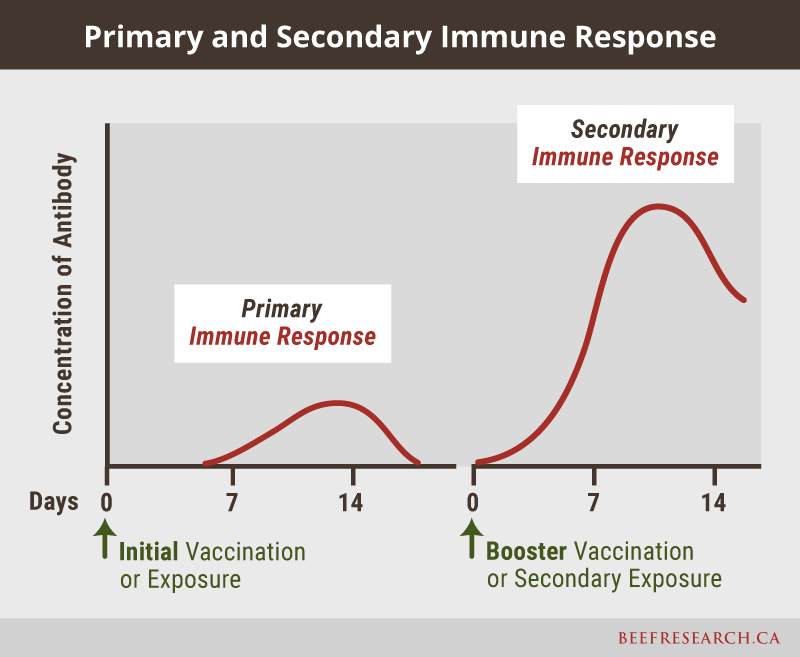
4. The timing of the vaccine was incorrect. With many vaccines it is important to match the animal’s immune response to the time period of highest risk for disease. Vaccines do not provide immediate protection to the animal. They typically require several weeks to develop peak levels of antibodies after a vaccine is given. This may be shortened if an animal has previously been vaccinated as their immune system will have a secondary or anamnestic response which is faster than the initial immune response.
Most cases of respiratory disease in weaned beef calves happen during the high-risk period after weaning and transportation to the feedlot with disease often seen shortly after arrival to the feedlot. Calves that are vaccinated prior to this risk period and have had adequate time for immunity to develop will usually have better immunity during the high-risk period than calves that are first vaccinated when they arrive in the feedlot.
In many cases, the timing of the vaccine is driven by an attempt to have the highest level of antibodies produced during the period of highest risk. Scours vaccines are given to cows in late pregnancy to have the highest levels of antibodies in the colostrum available to the newborn calf. Viral vaccines containing bovine viral diarrhea (BVD) virus should be given to the cow prior to breeding in order to have the highest levels of antibodies circulating in the cow’s system to protect the fetus in early gestation.
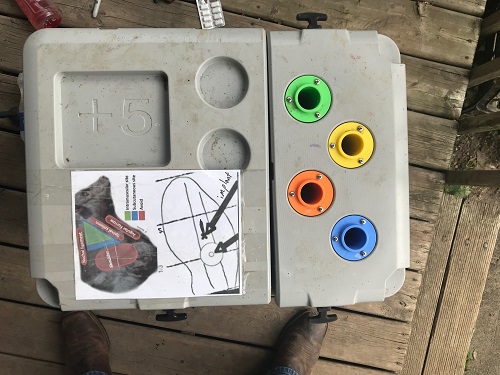
5. The vaccine was not stored properly. Most vaccines require storage at cool temperatures. Freezing or high temperatures will inactivate many vaccines. Mix only enough vaccine for an hour or less and discard leftover modified live vaccines. An insulated cooler helps maintain the right temperature. Make sure the refrigerator you store vaccines in is working correctly and keeping the vaccine at the correct storage temperature.
6. Maternal antibody interference can potentially limit a vaccine’s effectiveness in a very young calf. Calves that receive adequate colostrum have antibodies from their mother in their bloodstream. Many studies have shown that young calves with good levels of maternal immunity may not increase their antibody levels much after vaccination with injectable vaccines. The route of administration may also make a difference as maternal antibodies may not cause as much interference with intranasal vaccines as with injectable vaccines. However, it would appear that regardless of the route of administration, vaccinating young calves still stimulates cell mediated immunity and there may be additional responses in later vaccinations because of memory cell responses. Maternal antibody interference with vaccination of the young calf is not absolute and depends on a number of factors.
7. Stressors such as poor nutrition, castration, dehorning, weaning and transportation can diminish the immune system response through the effect of stress hormones such as corticosteroids. Newborn calves have high levels of corticosteroids from the birthing process for the first week of life which may limit their immune response during this period. If possible, vaccinations should not be given during periods of high stress.
8. Heavy infection pressure along with stress can overwhelm immunity that vaccines have created. Vaccines rarely can provide perfect protection and as a result, poor management practices such as overstocking, inadequate housing or adverse environmental conditions (e.g. dirty and contaminated calving areas), and ineffective biosecurity practices can create a pathogen challenge that can overwhelm the immune system even if the vaccine has provided some immunity.
Some Important Points to Remember When Using Vaccines
1. Read the label! The dose, withdrawal times, expiration date, timing, route of administration and safety information are all there.
2. Don’t combine vaccines! Mixing various vaccines together in one syringe can inactivate both vaccines. Multiple vaccinations should be spaced apart in separate locations. Follow the label directions.
3. Mix enough vaccine for only one hour or less. Keep the vaccine away from extreme heat or cold.
4. Get the air out of your automatic syringe. Trapped air can dramatically affect the amount of vaccine you are actually administering.
5. Keep your equipment clean. Use hot water only for cleaning automatic syringes. Soaps and disinfectants can leave a residue that destroys modified live vaccines.
6. Use an appropriate sized needle for the job. For cattle >500 lbs, usually an 18-16-gauge needle that is ½” – ¾” long for subcutaneous injections and 1” – 1 ½” long for intramuscular injections.
7. Change needles frequently (at least every 10-15 animals) and give all injections in the neck area. Don’t contaminate your vaccine bottle by utilizing a used dirty needle when you load your syringe. Only sterile needles should be used in the vaccine bottle.
8. Keep detailed records. Keep track of what vaccines you use including exact product name and serial and lot numbers. Records should include the data and clear descriptions of the group of animals vaccinated as well as the route of administration.
Video: Beef Research School – Developing & Implementing a Vaccination Program
Modified Live Vaccines in Breeding Animals and Pregnant Cows
Modified live vaccines (MLV) are known to be very effective against diseases such as infectious bovine rhinotracheitis (IBR) and bovine viral diarrhea (BVD), and they provide some of the best immunity against these diseases. In fact, the MLV given prior to breeding cows often provide the greatest fetal protection against diseases such as BVD (look for the “FP” in the vaccine name which denotes fetal protection claims). However, the MLV do have some inherent risks associated with them. Dr. Daniel Givens and Dr. Benjamin Newcomer addressed these risks in a recent paper delivered at the American Association of Bovine Practitioner’s conference in September of 2017. The three major risks that they discussed in that paper included the following three circumstances.
- Administering a live vaccine to calves nursing pregnant cows that have not been previously vaccinated is one of the potential risks. You will often read in the label precautions for MLV a warning such as “Do not use in calves nursing pregnant cows unless their dams were vaccinated within the past 12 months”. The potential risk is that the MLV could multiply within the calves after vaccination and potentially be transferred to the non-vaccinated dams and heifers which could possibly cause abortion to occur. There have been several studies on this unlikely scenario and the results have been mixed. In some studies, there was no evidence of transmission from vaccinated calves while in others there was some potential transmission occurring. This seems like a very low risk scenario and it is easily prevented by ensuring your cows and heifers are vaccinated well.
- The second risk is the potential of causing infertility by giving a MLV too close to the breeding season. Many labels will suggest that they should be administered at least 30 days prior to breeding. The IBR virus component of the MLV has the potential to cause inflammation of the ovaries and could potentially affect the next estrus cycle if given too close to the start of the breeding season. he studies described by Drs. Givens and Newcomer would suggest that this is most likely a risk again in animals being vaccinated for the first time. Therefore, when vaccinating replacement heifers or other animals that haven’t been vaccinated previously, you should follow the 30-day rule and vaccinate them at least 30 days before the breeding season begins. Many of the studies showed no impact of a MLV given close to the breeding period in previously vaccinated animals, however, it is probably a risk to be aware of and avoid if possible.
- The final risk and perhaps the most important one to be aware of is that some MLV can potentially cause abortion if given to pregnant cows. This is probably a much greater risk in animals that have not been previously vaccinated but is certainly a significant risk to consider. Some available MLV have label claims that allow pregnant cows to be vaccinated, “provided that they were vaccinated, according to label directions, with this same product within the past 12 months”. It is critically important that if MLV are given to pregnant cows, that these instructions be followed very carefully. Note the phrasing of the instructions which include “with this same product”; it is extremely important that the identical vaccine from the same manufacturer has been given appropriately in the past 12 months.
When used according to label and veterinary instructions, the vaccines we utilize for IBR and BVD virus provide safe and highly effective protection against abortion. Work closely with your veterinarian to decide on a vaccine protocol that is most effective for your herd’s management. Store and handle your vaccines appropriately and follow the label directions for administration. These risks are easily controlled and are no longer an issue if your vaccines are used according to the label directions.
Watch this podcast on WeCAHN (Western Canadian Animal Health Surveillance Network) on beef herd vaccinations: https://wecahn.podbean.com/e/beef-cow-calf-vaccination-planning/
Vaccine Reactions
While vaccine reactions are a rare occurrence, they do occur, and these can range from minor localized swellings and lumps to a major anaphylactic reaction. Typically, serious adverse reactions occur in only 1 in every 10,000 animals, however reactions might be more common in vaccines with high levels of endotoxin such as E. coli vaccines and pinkeye vaccines or in some killed vaccines with oil-based adjuvants. Certain breeds and genetic lines may be more susceptible to vaccine reactions and as a result some producers may be more likely to have an animal experience a reaction. Symptoms of an anaphylactic reaction can occur within minutes of vaccination and may involve shaking, sweating, weakness, staggering, rapid breathing and collapse. Cattle should be kept under observation for 30 minutes after vaccination and epinephrine (Epichlor) can be administered, preferably by IV injection, to animals that experience severe anaphylactic reactions.
Infections or abscesses can also occasionally occur at the injection site reducing or inactivating the usefulness of the vaccine. This does not happen very often and is most common when needles are dirty, not changed often enough, if the vaccine is contaminated by a dirty needle or if the cattle are vaccinated when their hides are wet and dirty.
Vaccination Protocols
There are a wide variety of vaccines available for beef cattle and the protocol for your herd will be highly dependent on your management system, other biosecurity factors, as well as some geographic differences in disease occurrence. Designing a vaccination program will depend on both an understanding of the immune system, but also of your herd’s history and management.
Some of the basics of these vaccination programs will definitely include vaccines for Infectious Bovine Rhinotracheitis (IBR), Bovine Viral Diarrhea virus (BVD) as well as vaccines for clostridial diseases. However, the timing of administration, the type of vaccine utilized, and the other vaccines necessary for your animals will vary across farms and regions. Your veterinarian can create a customized vaccination protocol for your herd. Designing a vaccination program that provides appropriate immunity for the right pathogens at the right time in the right animals is an essential and primary component of any herd health program.
Vaccination has been a proven tool for disease prevention for many years and because it is virtually impossible to keep our herds closed and unexposed to some diseases, vaccines are a very important component of our biosecurity programs. Many of the diseases we vaccinate beef cattle for can have devastating economic consequences in terms of treatment costs, mortality and especially in terms of reproductive losses. The primary motivation reported by beef producers for using vaccines is to prevent a wreck, even if they had no issue in the past. The BCRC Cost Benefit of Using Vaccines tool allows producers to evaluate the potential economic benefits of using BVD vaccines in their herd by evaluating the potential of reproductive loss that could occur caused by abortions.
Video: Economical Vaccine Protocols
Vaccine Use in Canadian Cow-Calf Herds
In 2020, 146 cow-calf herds from across Canada reported antimicrobial usage (AMU)3. In 2020, vaccine usage was studied in the same herds. Median size of herds was approximately 130 cows2.
The following infographics highlight the major findings of these studies:
Vaccination Infographics & Guidelines
- Disease Infographics
-
- Vaccine Guidelines
-
Core Vaccine List
Core Vaccination Guidelines
Risk-Based Vaccine Guidelines
Beef Cattle Biological Chart
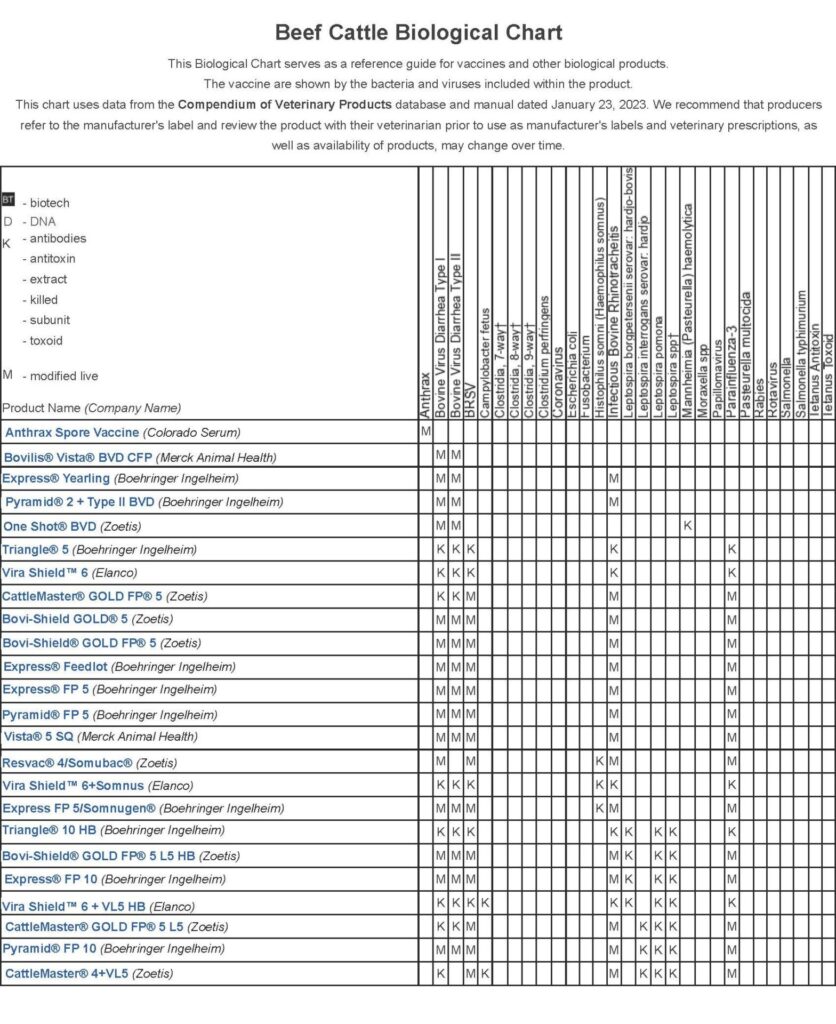
Click for three-page PDF. Beef Calf Diarrhea Decision Tree
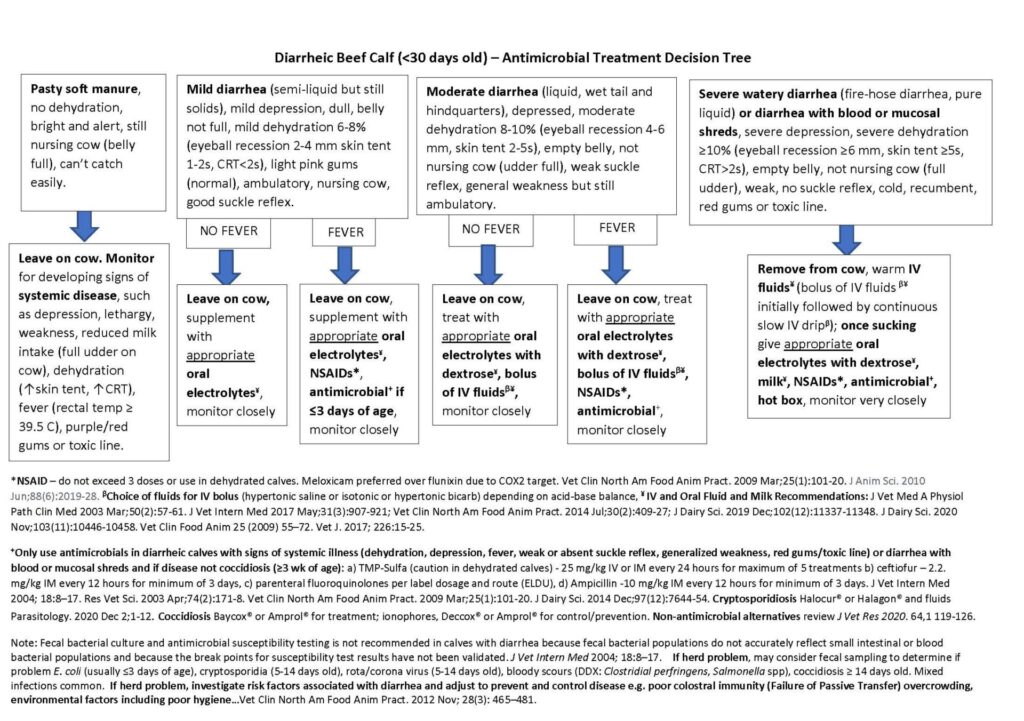
Click for PDF.
- References
-
1. Givens, M.D. and B.W. Newcomer. 2017. Does modified-live viral vaccine administration to heifers or cows lack substantial risk? AABP Annual Conference Proceedings, 2017: 43-48.
2. Lazurko, M. M., Erickson, N. E. N., Campbell, J. R., Gow, S., and Waldner, C. L. 2023. Vaccine use in Canadian cow-calf herds and opportunities for improvement. Front. Vet. Sci. Available online.
3. Fossen, J. D., Campbell, J. R., Gow, S., Erickson, N., and Waldner, C. L. 2023. Antimicrobial Use in Canadian Cow-Calf Herds. Vet. Sci. 10(5): 366. Available Online.
Feedback
Feedback and questions on the content of this page are welcome. Please e-mail us.
Acknowledgements
Thanks to:
- Dr. John Campbell, Professor and Researcher in the Department of Large Animal Clinical Sciences, Western College of Veterinary Medicine, University of Saskatchewan, for contributing his time and expertise in the development of this page.
- Dr. Cheryl Waldner, Professor and Researcher in the Department of Large Animal Clinical Sciences, Western College of Veterinary Medicine, University of Saskatchewan, for contributing her time and expertise to reviewing this page.
This content was last reviewed June 2025.
